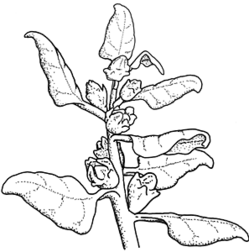
Description: Sprawling or climbing, annual or perennial herbs or small shrubs.
Leaves alternate, flat, entire, somewhat succulent, usually papillose.
Flowers green or yellow, sessile or pedicellate, in axillary clusters of 1–5; bracts absent. Perianth lobes mostly 4 or 5. Stamens 4–many, alternating with perianth lobes or scattered, filaments fused to perianth tube; staminodes absent. Ovary inferior; loculi as many as styles, ovules 1 per loculus, placentation apical; styles 2–10, free.
Fruit indehiscent, dry or succulent, with hard endocarp, ridged, winged or horned, sometimes papillose; seeds 1–several.
Distribution and occurrence: World: c. 50 species cosmopolitan, largely in Southern Hemisphere, especially southern Africa. Australia: 8 species (5 species native), all States except N.T.
Text by S. W. L. Jacobs & J. Highet
Taxon concept:
| | Key to the species | |
| 1 | Flowers pedicellate; pedicels at least 4 mm long | Tetragonia decumbens |
| Flowers sessile or subsessile | 2 |
| 2 | Flower bud with distinct ridges that develop into lateral wings not appreciably extending above the ovary; stamens 4 | Tetragonia eremaea |
| Flower bud without distinct ridges; ridges developing and extending above ovary in the fruiting stage; stamens 4–many
Back to 1 | 3 |
| 3 | Flowers solitary; ovary rounded, not projecting; stamens 4–numerous | 4 |
| Flowers in clusters of usually 3–5; ovary conical, almost as long as perianth; stames 4 or rarely 3
Back to 2 | Tetragonia microptera |
| 4 | Projections of fruit claw-like and incurved, sometimes erect; leaves narrow broad-ovate, elliptic or rhombic and gradually narrowed to the petiole; stamens 4–8 | Tetragonia moorei |
| Projections of fruit horn-like and ± divergent; leaves usually triangular-ovate and ± abruptly narrowed to a cuneate base, narrowing to the petiole; stamens usually 8–22
Back to 3 | Tetragonia tetragonoides |
|


